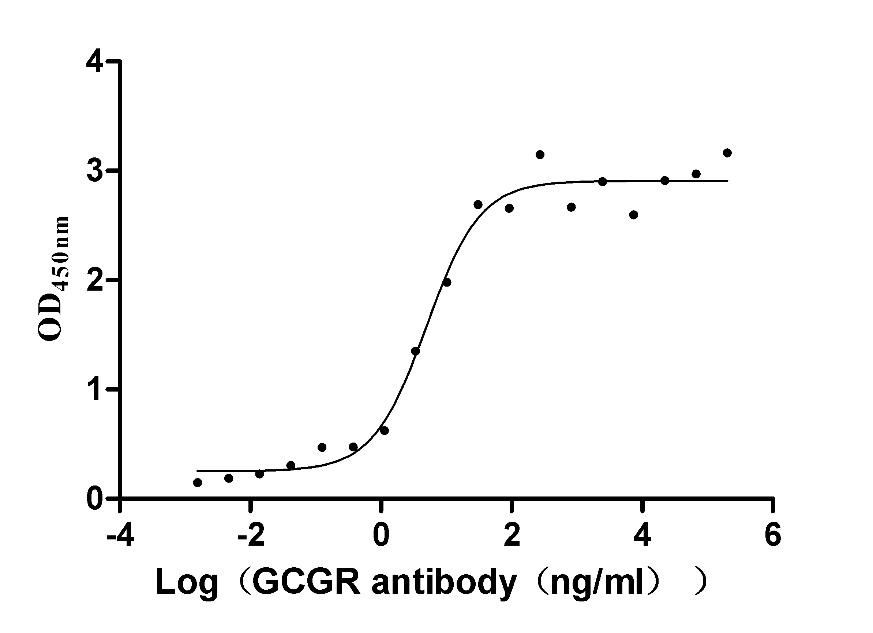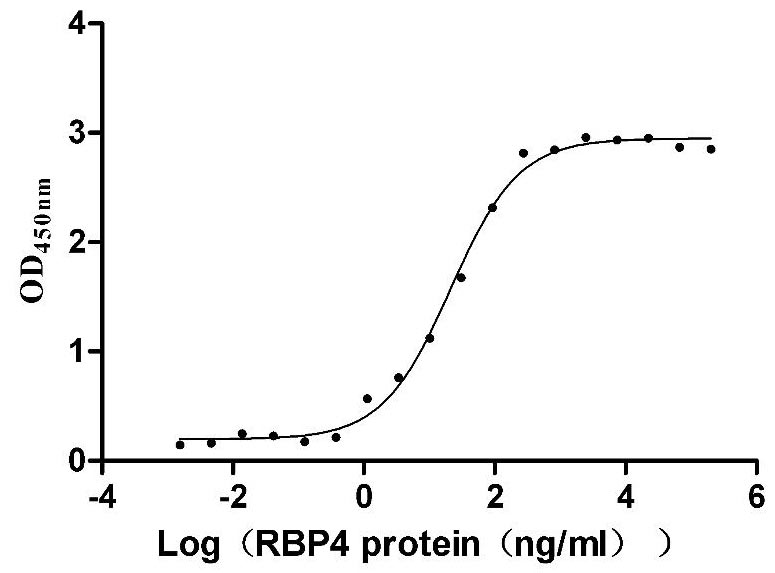Recombinant Mouse Suppressor of cytokine signaling 2 (Socs2)
-
货号:CSB-YP022389MO
-
规格:
-
来源:Yeast
-
其他:
-
货号:CSB-EP022389MO
-
规格:
-
来源:E.coli
-
其他:
-
货号:CSB-EP022389MO-B
-
规格:
-
来源:E.coli
-
共轭:Avi-tag Biotinylated
E. coli biotin ligase (BirA) is highly specific in covalently attaching biotin to the 15 amino acid AviTag peptide. This recombinant protein was biotinylated in vivo by AviTag-BirA technology, which method is BriA catalyzes amide linkage between the biotin and the specific lysine of the AviTag.
-
其他:
-
货号:CSB-BP022389MO
-
规格:
-
来源:Baculovirus
-
其他:
-
货号:CSB-MP022389MO
-
规格:
-
来源:Mammalian cell
-
其他:
产品详情
-
纯度:>85% (SDS-PAGE)
-
基因名:
-
Uniprot No.:
-
别名:Socs2; Cis2; Cish2Suppressor of cytokine signaling 2; SOCS-2; Cytokine-inducible SH2 protein 2; CIS-2
-
种属:Mus musculus (Mouse)
-
蛋白长度:Full length protein
-
表达区域:1-198
-
氨基酸序列MTLRCLEPSG NGADRTRSQW GTAGLPEEQS PEAARLAKAL RELSQTGWYW GSMTVNEAKE KLKEAPEGTF LIRDSSHSDY LLTISVKTSA GPTNLRIEYQ DGKFRLDSII CVKSKLKQFD SVVHLIDYYV QMCKDKRTGP EAPRNGTVHL YLTKPLYTSA PTLQHFCRLA INKCTGTIWG LPLPTRLKDY LEEYKFQV
-
蛋白标签:Tag type will be determined during the manufacturing process.
The tag type will be determined during production process. If you have specified tag type, please tell us and we will develop the specified tag preferentially. -
产品提供形式:Lyophilized powder
Note: We will preferentially ship the format that we have in stock, however, if you have any special requirement for the format, please remark your requirement when placing the order, we will prepare according to your demand. -
复溶:We recommend that this vial be briefly centrifuged prior to opening to bring the contents to the bottom. Please reconstitute protein in deionized sterile water to a concentration of 0.1-1.0 mg/mL.We recommend to add 5-50% of glycerol (final concentration) and aliquot for long-term storage at -20℃/-80℃. Our default final concentration of glycerol is 50%. Customers could use it as reference.
-
储存条件:Store at -20°C/-80°C upon receipt, aliquoting is necessary for mutiple use. Avoid repeated freeze-thaw cycles.
-
保质期:The shelf life is related to many factors, storage state, buffer ingredients, storage temperature and the stability of the protein itself.
Generally, the shelf life of liquid form is 6 months at -20°C/-80°C. The shelf life of lyophilized form is 12 months at -20°C/-80°C. -
货期:Delivery time may differ from different purchasing way or location, please kindly consult your local distributors for specific delivery time.Note: All of our proteins are default shipped with normal blue ice packs, if you request to ship with dry ice, please communicate with us in advance and extra fees will be charged.
-
注意事项:Repeated freezing and thawing is not recommended. Store working aliquots at 4°C for up to one week.
-
Datasheet :Please contact us to get it.
靶点详情
-
功能:SOCS family proteins form part of a classical negative feedback system that regulates cytokine signal transduction. SOCS2 appears to be a negative regulator in the growth hormone/IGF1 signaling pathway. Probable substrate recognition component of a SCF-like ECS (Elongin BC-CUL2/5-SOCS-box protein) E3 ubiquitin ligase complex which mediates the ubiquitination and subsequent proteasomal degradation of target proteins.
-
基因功能参考文献:
- SOCS2 negatively regulates the development of natural killer cells by inhibiting JAK2 activity via direct interaction. PMID: 28383049
- the absence of SOCS2 is protective against bone loss typical of inflammatory bowel disease. PMID: 29343614
- SOCS2 deletion had no effect on total dendrite length, number of dendritic segments, number of branch points or total dendritic spine density but increased the number of mature "mushroom" spines. PMID: 27655030
- The induction of a tolerogenic phenotype in DCs by NPs was mediated by the AhR-dependent induction of Socs2, which resulted in inhibition of nuclear factor kappaB activation and proinflammatory cytokine production (properties of tolerogenic DCs). PMID: 27330188
- Upon deletion of the STAT5 response elements from the Socs2 promoter in mice, cytokine induction was abrogated, while basal activity remained intact. Our data suggest that promoter-bound STAT5 modulates cytokine responses and enhancer-bound STAT5 is mandatory for gene activation. PMID: 28009300
- In a knockout mouse model, deficiency of SOCS2 was associated with decreased neuroinflammation and increased survival following HSV-1 infection, without significant effect on viral load. This result indicates that SOCS2 plays a major role in driving neuroinflammation and subsequent brain damage during HSV-1 encephalitis. PMID: 27646480
- Our data show that absence of SOCS2 turns cardiomyocytes unresponsive to LIF-induced [Ca(2+)] raise, indicating that endogenous levels of SOCS2 are crucial for full activation of LIF signaling in the heart. PMID: 28122728
- Knockdown of SOCS2 makes mice less sensitive to multiple low dose streptozotocin. PMID: 26562042
- Study provides an insight into the role of SOCS2 in modulating the immune response to Bovine herpesvirus 5 [BoHV-5]infection. PMID: 27477504
- Data (including data from studies in knockout mice) suggest Socs2 regulates liver regeneration rate after partial hepatectomy, Ghr (growth hormone receptor) level via ubiquitination/proteolysis, and serum Igf1 (insulin-like growth factor-1) level. PMID: 26703468
- GH appears to act directly on the metatarsals of Socs2(-/-) mice, promoting growth via a mechanism that is independent of IGF-1. PMID: 25833299
- comparison of murine wt and Socs2(-/-) HSC gene expression in response to 5-FU revealed a significant overlap with the molecular programs that correlate with SOCS2 expression in leukemias, particularly with the oncogenic pathways PMID: 25858143
- Studies indicate the critical role of suppressor of cytokine signaling 2 (SOCS2) in ontrolling the local growth hormone (GH) anabolic bone effects. PMID: 25074853
- Taken together, our observations indicated that SOCS2 could suppress myotube formation, act as an anti-regulator of mitochondria biogenesis via inhibiting p38 MAPK signal pathway. PMID: 24352701
- SOCS2 immunoprecipitates with TrkA and a juxtamembrane motif of TrkA is required for this interaction. Over-expression of SOCS2 in PC12 Tet-On cells increased total and surface TrkA expression. SOCS2 regulates neurite outgrowth. PMID: 24484474
- Results show that CISH has no non-redundant functions in beta cell proliferation or glucose homeostasis during pregnancy in mice. Socs2 might compensate for the loss of Cish during pregnancy. PMID: 23949579
- SOCS2-mediated feedback regulation of the JAK/STAT pathway is deficient in BCR/ABL1-induced chronic myeloid leukemia. PMID: 22824785
- SOCS2 plays a role in modulating heart damage and function in a murine model of acute Chagas disease. PMID: 22658486
- This study identified SOCS2 as an important regulator of hepatic homeostasis under conditions of high-fat dietary stress. PMID: 22562833
- SOCS2-induced proteasome-dependent TRAF6 degradation is a common anti-inflammatory pathway for control of innate immune responses. PMID: 22693634
- SOCS2 is the critical regulator of GH action in murine growth plate chondrogenesis. PMID: 22228213
- SOCS2 regulates cellular growth hormone receptor levels through direct ubiquitination and in a proteasomally dependent manner PMID: 21980433
- We propose a model in which SOCS2 acts as a negative regulator of TLR-induced dendritic cell activation PMID: 21844389
- in in vivo models of atopic dermatitis and allergen-induced airway inflammation, SOCS2(-/-) mice show significantly elevated IgE, eosinophilia, type 2 responses, and inflammatory pathology relative to wild-type mice PMID: 21646394
- SOCS-2-/- knockout mice have a normal function of insulin-producing pancreatic beta-cells. PMID: 21099320
- The induction of SOCS 1-3 after peripheral infection with West Nile virus or tick-borne encephalitis virus in the murine model are reported. PMID: 20854017
- Suppressor of cytokine signaling-2 gene disruption promotes Apc(Min/+) tumorigenesis and activator protein-1 activation PMID: 20348236
- Our results suggest that SOCS2 is not a physiological regulator of SOCS3 expression and action in primary haemopoietic cells. PMID: 19919527
- Growth enhancement in suppressor of cytokine signaling 2 (SOCS-2)-deficient mice is dependent on signal transducer and activator of transcription 5b (STAT5b). PMID: 12040024
- examination of whether increased levels repress growth of animals in vivo PMID: 12208853
- SOCS2 promotes neuronal differentiation by blocking growth hormone-mediated downregulation of Ngn1. PMID: 12368809
- Induction of SOCS2 in response to EPO stimulation appears to depend on Stat5 but not on MAP kinase or phosphatidylinositol 3-kinase. SOCS2 has the longest-lived transcript. SOCS2 is less effective at counteracting EPO-mediated events PMID: 12396724
- SOCS2-deficient mice show a 30% decrease in density of NeuN positive neurons in cortex compared to wildtype. Analysis of glial cell numbers in stained sections of cortex show that the neuron to glia ratio is decreased in SOCS2 knockout mice. PMID: 15090034
- SOCS-2 is a growth hormone-inducible, novel inhibitor of intestinal epithelial cell proliferation and intestinal growth. PMID: 15300589
- estrogen, via ERalpha, up-regulated hepatic expression of SOCS-2 and -3, probably through transcriptional activation. PMID: 15319356
- Socs2 is a primary TCDD-inducible gene that may represent a novel mechanism by which TCDD elicits its immunosuppressive effects. PMID: 15371557
- Cortical neurons derived from transgenic mice that over-express SOCS2 had an increased rate of neurite outgrowth and an increased length and number of primary neurites compared with wild-type neurons. PMID: 15525267
- SOCS2 deficiency partially mimics a state of increased GH activity, but also results in changes that cannot be related to known GH effects PMID: 15563548
- SOCS2 is a negative regulator of growth hormone signaling. PMID: 15690087
- GH and SOCS2 have been shown to regulate neural development, neural stem cell differentiation and neuronal growth. Might have important therapeutic implications for both repairing nervous system injuries and treating neurological disease. (Review) PMID: 15734145
- SOC-2 induced by GH may play an important role in suppressing collagen accumulation and mesenchymal cell proliferation induced by GH or GH-induced IGF-I PMID: 15831713
- Over-expression of SOCS2 variably affects different cortical regions and neuronal populations, with the predominant effect appearing to be on interneurons and neuronal connectivity in the cortex. PMID: 15837129
- Although SOCS2 expression can regulate neuronal morphology, it appears to have little effect on neuronal ion channel expression. PMID: 16360125
- Socs2 was expressed ubiquitously in mouse tissues, including pancreatic beta-cell lines. PMID: 16406727
- Results suggest that SOCS-2 positively regulates endogenous JunB protein expression in C2C12 cells through inhibition of JunB destabilization by the ubiquitin-proteasome pathway, and thereby regulates the cell fate of mesenchymal precursors. PMID: 16419040
- Socs2 and Elf5 are key members of the set of prolactin-regulated genes that mediate prolactin-driven mammary development. PMID: 16469767
- We conclude that SOCS2 normally limits basal and IGF-I- and EGF-induced intestinal growth in vivo and has novel inhibitory effects on the IGF-IR tyrosine kinase pathway in intestinal epithelial cells. PMID: 16574995
- mice over-expressing SOCS-2 showed increased survival of neurons generated during adult hippocampal neurogenesis PMID: 18566962
- The present study examined the role of SOCS2 in endochondral ossification and trabecular and cortical bone formation. PMID: 18803233
显示更多
收起更多
-
组织特异性:Expressed primarily in the testis, some expression in liver and lung.
-
数据库链接:
KEGG: mmu:216233
STRING: 10090.ENSMUSP00000020215
UniGene: Mm.474283
Most popular with customers
-
Recombinant Human Glucagon receptor (GCGR), partial (Active)
Express system: Mammalian cell
Species: Homo sapiens (Human)
-
Recombinant Rabbit Tissue factor pathway inhibitor (TFPI) (Active)
Express system: Mammalian cell
Species: Oryctolagus cuniculus (Rabbit)
-
Recombinant Human Intestinal-type alkaline phosphatase (ALPI) (Active)
Express system: Mammalian cell
Species: Homo sapiens (Human)
-
Recombinant Mouse Transthyretin (Ttr) (Active)
Express system: Mammalian cell
Species: Mus musculus (Mouse)
-
Recombinant Human Zymogen granule protein 16 homolog B (ZG16B) (Active)
Express system: Mammalian cell
Species: Homo sapiens (Human)
-
Recombinant Rat Gastric inhibitory polypeptide receptor (Gipr), partial (Active)
Express system: Mammalian cell
Species: Rattus norvegicus (Rat)
-
Recombinant Human Urokinase-type plasminogen activator(PLAU) (Active)
Express system: Mammalian cell
Species: Homo sapiens (Human)
-
Express system: Mammalian cell
Species: Homo sapiens (Human)




















